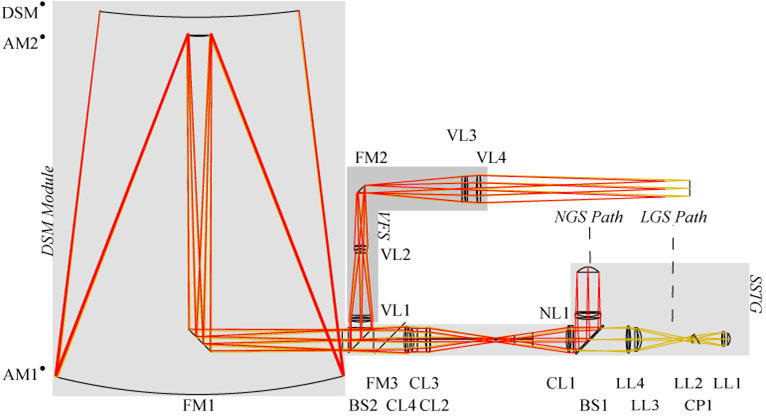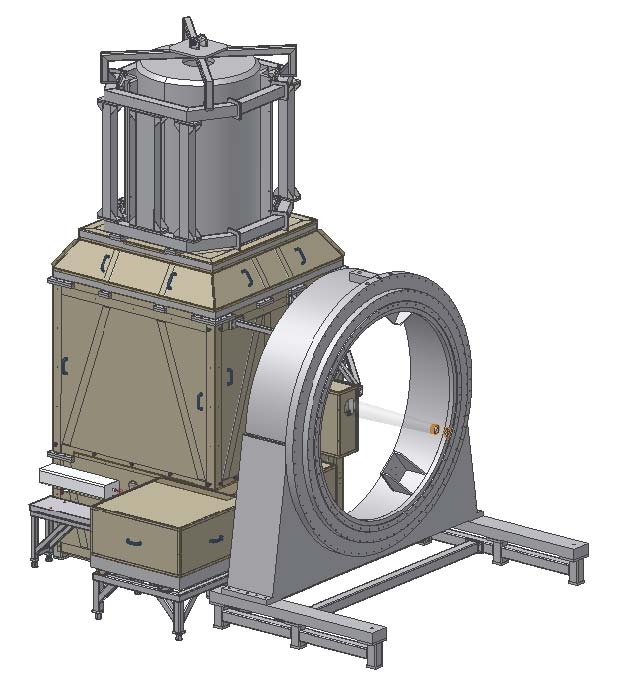ASSIST
It is intended to test thoroughly, in Europe, all the systems composing the AO Facility before delivery in Paranal. The AOD is convinced that this strategy was a key-element to the success of the commissioning of the first generation AO modules delivered by AOD.
ASSIST (Adaptive Secondary Simulator and Instrument Testbed) is a collaboration between NOVA (Nederlandse Onderzoekschool voor de Astronomie)(PI: Remko Stuik) and ESO
However, in the case of the AOF such strategy implies a serious challenge, the main one being how to design a Test Bench allowing the implementation of a 1.1 convex aspheric deformable mirror in the optical path !!! An ingenious solution was found by optical designer B.Delabre (ESO) and is now used as a baseline by the ASSIST developer team in Leiden.
Contents
Requirements
ASSIST must provide a long and sophisticated list of functionalities:
- Use the DSM 1.1m convex mirror in the optical path
- provide a f/19.53 Nasmyth-like opto-mechanical I/F for the output focal plane
- provide a large FOV (2.5 arcmin)
- provide high optical quality at 2 wavelengths: 589 nm (laser beam) and 1.6 micron (scientific corrected wavelength)
- low pupil distortion (to insure a good match between actuator geometry on the DSM and the WFS apertures distribution)
- provide laser and natural light sources at the input focal plane, of variable intensity
- simulate turbulent wavefront in the whole field of view affected by a multi-layered turbulence at a level of 0.6 to 1.1" seeing
- be operated by a simple soft. GUI
Optical and Mechanical Design
The fundamental problem is that in order to test a 1.1m convex piece of optics, one needs an optical component > 1.1m. It already implies that the test setup will require a large volume and meter-telescope size optical components.
The Figure 1 shows this optical design. The component "AM1" is the main mirror and is a concave aspheric surface of 1.7m diameter. This is the heart of the test bench. A second smaller aspheric mirror (140mmdiameter) is located above , just below the surface of the DSM.Beam splitters/mirrors will allow to fold the beam on the side for the input and output focal planes.

Figure 1: ASSIST Optical Design
The mechanical implementation take the form shown on Figure 2.

Figure 2: Opto-Mechanical Implementation of ASSIST.
ASSIST Role & Functions
The following list describes the test and characterization processes that will take place and that ASSIST will allow to perform:
- Optical Tests of the DSM
- Setup and Alignment of the AO modules
- DSM Flattening, measure of the Influence Functions,characterization of the mirror stroke
- Interaction Matrix measurement and loop closure
- Investigation of the various IM calibration methods proposed and evaluation of their performance
- Chopping tests, Field Stabilization tests, focusing
- Mounting of test cameras for delivered image correction
- Pupil alignment and study of Command Matrix for GLAO and LTAO
- LGS and Visible/IR NGS acquisition
- AO performance optimization
Next steps
The Final Design Review took place early July 09. The review should be closed by November 15th. The system will be in the manufacturing phase till end 2010.
What's new?
Check for the next lunch Talk.
Quick Links
- Home
- Adaptive Optics group expertise and activities
- Adaptive Optics Systems
- Adaptive Optics Technologies
- AO lunch talks
- Other useful links
Special Event: 20 years of Adaptive Optics at ESO
Contact Us
